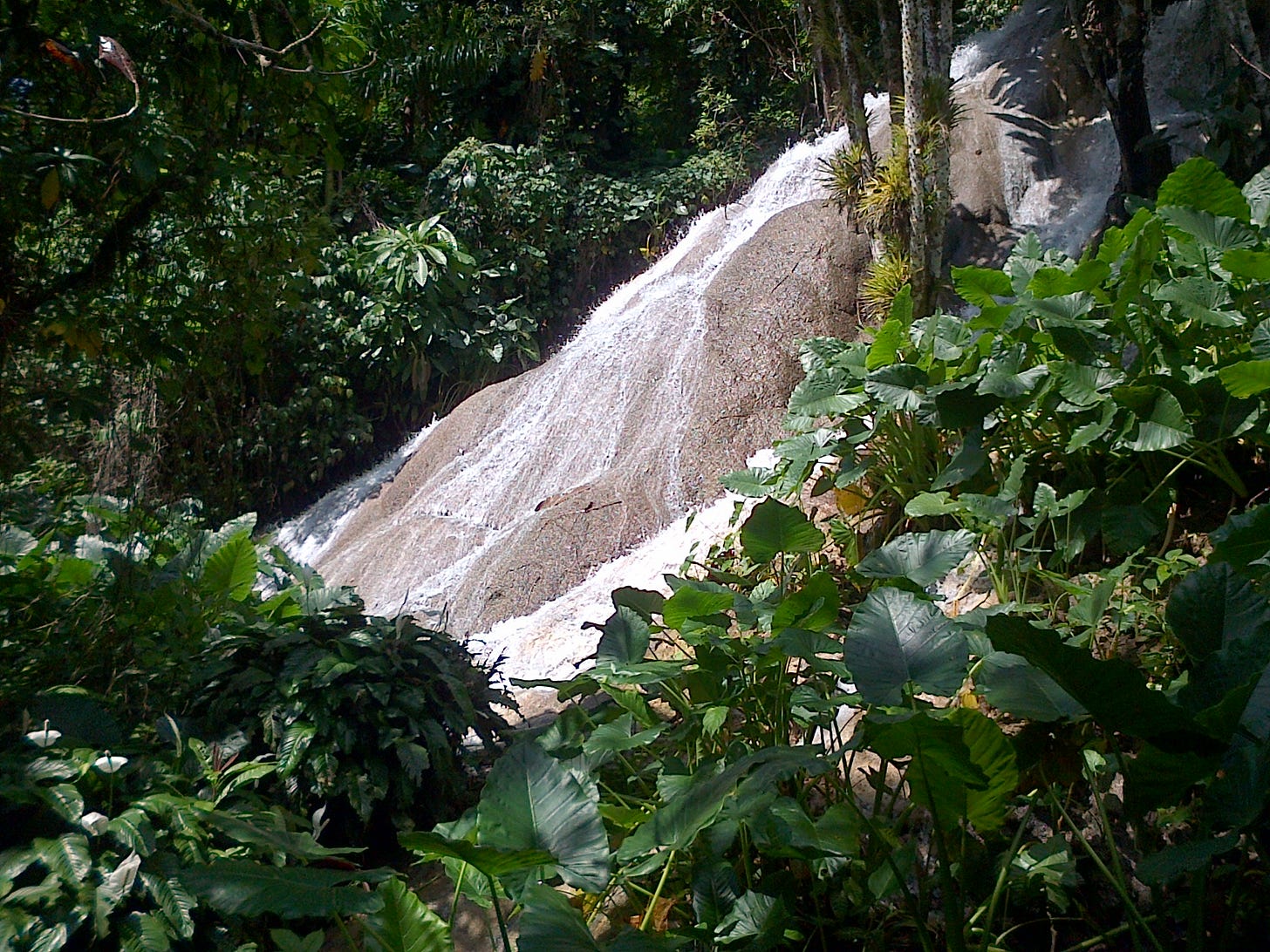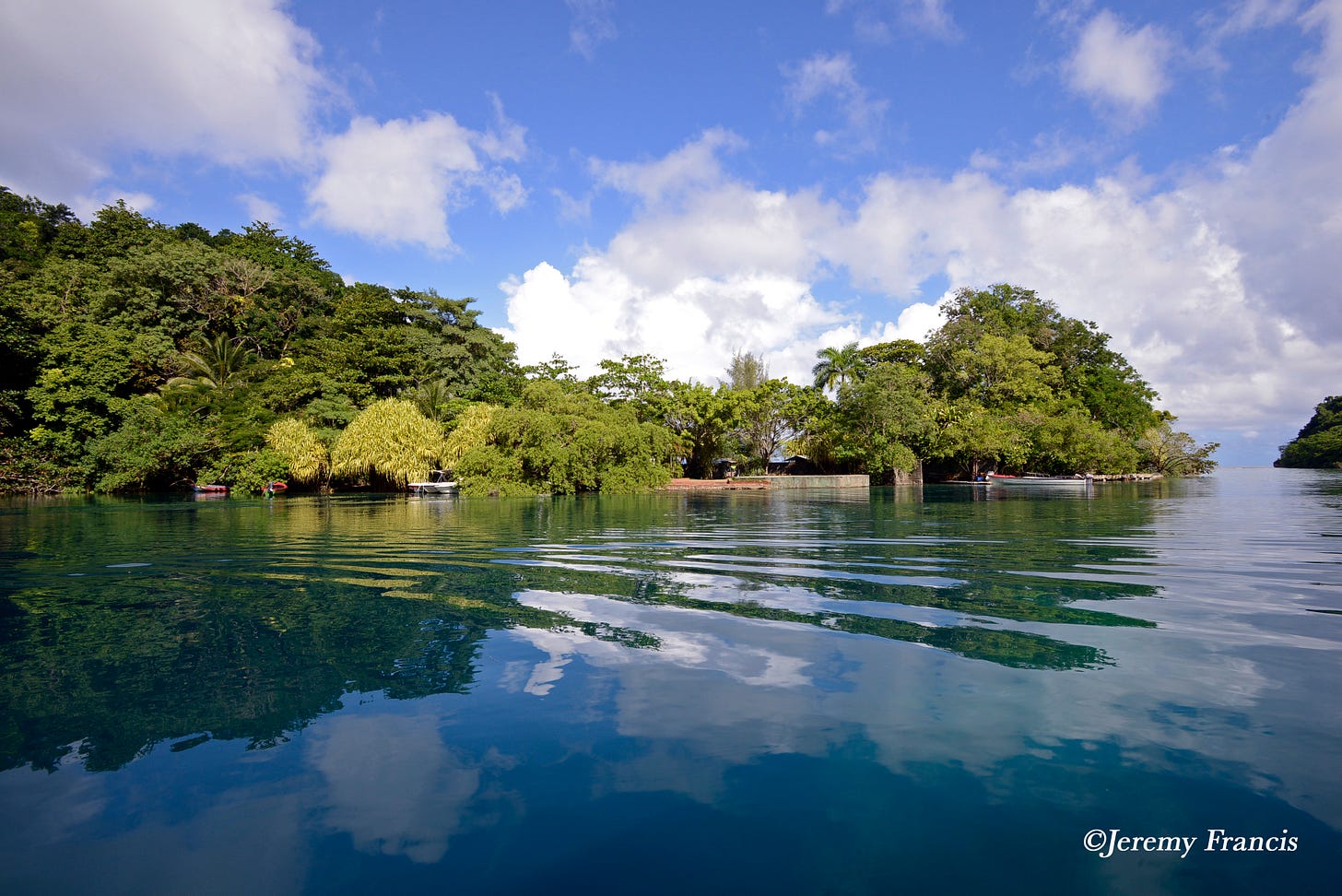Not saying where this is!
Imagine a section of a river, perhaps with waterfalls and rapids, big rocks and blue holes. Cars can’t get there, but local people know where it is and they use it, for domestic water, bathing, washing clothes, fishing, catching river shrimp, recreation. They get there on a path which winds through the bush and they keep it clear. Nobody knows who owns the land and nobody cares – it is their river, always been there, always will be. Then someone, maybe a youngster trying to raise money for school fees, maybe an older woman with an entrepreneurial impulse, brings a cooler with soft drinks and begins to sell them. More people come. The path is widened and a few steps cut, maybe a railing is built at the steepest parts. A taxi driver who lives in the district brings a few visitors to the nearest road and they hike through the bush. They love the river and the taxi driver makes a good money that day and so do the people selling drinks. Then someone decides to have a cookout, and more people begin to earn, more people visit. If this river is within let’s say an hour of the coast, tourists start to arrive at the ‘hidden treasure.’
At this point, two trajectories are possible – this place, formerly used exclusively by local people, and by local I mean, those who live very close to it, begins to see an influx of others, some from the parish, some from farther away. Structures are built, riverbanks are cleared of the vegetation which holds them in place. The river starts to look muddy. If the pools are deemed too shallow for swimming, a plan is hatched to create a deeper area, and in the dry season when flows are low, the river is temporarily diverted, and a hole is created with blocks and cement. Soon there are dozens, if not hundreds of people, visiting this place and conflicts begin for many different reasons. The state becomes concerned about crime and pollution and the river is ‘closed’, angering those who use it.
The second trajectory is that a tourism agency hears about it and becomes concerned about foreign visitors going off the beaten track. Anything could happen. A team is sent, and it is decided the place should become an attraction. Naturally, it needs access by motor vehicles, preferably buses. The track becomes a road with a car park and security outpost. It’s no longer free, because these ‘improvements’ must be paid for. Negotiations begin with those who were using the place for subsistence, enjoyment or income generation as to who can have a stall in the car park, who can get a job as a guide. Most are excluded. Bank clearing continues in order to landscape with blooming plants, so the place doesn’t look so bushy. And those who can pay come, more and more of them. Then a tour company seeks an exclusive right to use what has become an attraction and it is granted. Those who enjoyed the river when it was hard to access mount a protest. Policy papers are written, and workshops are held. The landowner surfaces and claims the river.
Underlying these events are two basic beliefs – that there is no limit to the number of people any natural place can welcome, and more is always better. To use the technical term, that there is no such thing as carrying capacity. And that every natural place should be made over to suit human beings, and it only has value once it can be monetized.
Blue Hole, Portland 2018 - thanks to Jeremy Francis for the lovely photo.
This is the broad context for the current conflict at Blue Hole in Portland, now called Blue Lagoon due to the persistent myth that a film of the same name was filmed there, except that the land around Blue Hole has been privately owned since the late 1960s and this has always been known. There are many other places on rivers or the sea where the process I describe above is underway. A visit to arguably the most popular tourist attraction in the Caribbean, Dunns River, on a cruise ship day will show the end game. Yes, the falls are still beautiful, if you can catch a glimpse of them between all the people, but the rocks are slick with algae and last time I visited with overseas family members, the banks smelled like a public bathroom.
Natural places have limits, if they are to remain natural, and they cannot be all things to all people all at the same time. If we believe we all should be able to go to rivers and the coastline, then we have to know and accept the carrying capacity of those places, we have to understand that we share them with non human inhabitants, and we must not litter, pollute or destroy vegetation. And the same rules must apply to landowners, visitors, tour operators and, emphatically, to the state.






I'm not suggesting that access should be denied because of any of the issues of the past. I'm suggesting that so far, and in my experience, there has been an unwillingness to establish that carrying capacity, and I'm glad to hear there is willingness to accept it when it is done. This unwillingness is not just applicable to Blue Hole, by the way, but many similar places in Jamaica. In fact, the only so called attraction I know about that enforces a carrying capacity is YS Falls In St Elizabeth. If there are others, I would be grateful to learn about them. Thanks for your comment.
I do remember... wish I could find some old photos...